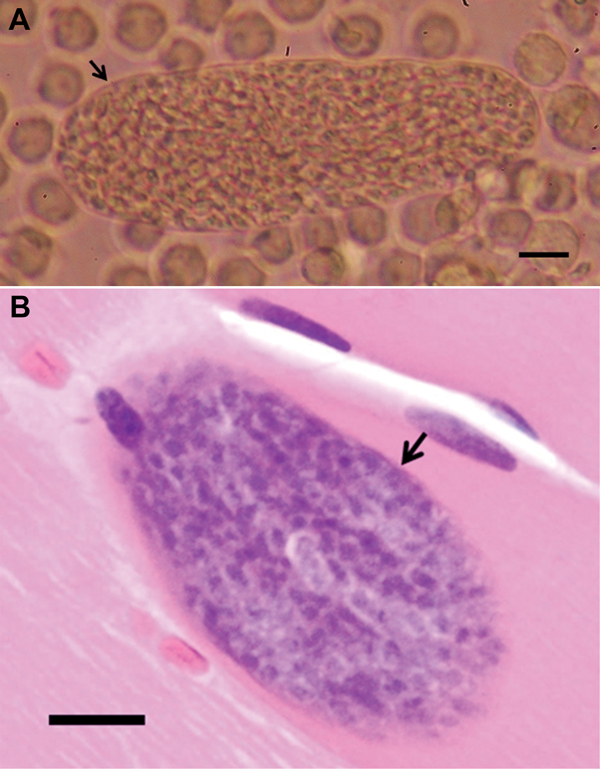Sarcocystis Nesbitti on:
[Wikipedia]
[Google]
[Amazon]
''Sarcocystis nesbitti'' is a species of
 An outbreak investigation was conducted on 93 symptomatic persons from
An outbreak investigation was conducted on 93 symptomatic persons from
Apicomplexa
The Apicomplexa (also called Apicomplexia) are a large phylum of parasitic alveolates. Most of them possess a unique form of organelle that comprises a type of non-photosynthetic plastid called an apicoplast, and an apical complex structure. The ...
.
__TOC__Human infection
 An outbreak investigation was conducted on 93 symptomatic persons from
An outbreak investigation was conducted on 93 symptomatic persons from Malaysia
Malaysia ( ; ) is a country in Southeast Asia. The federation, federal constitutional monarchy consists of States and federal territories of Malaysia, thirteen states and three federal territories, separated by the South China Sea into two r ...
following a college retreat on January 17–19, 2012, on Pangkor Island
Pangkor Island ( ms, Pulau Pangkor) is an island in Manjung District, Perak, Malaysia. It has a population of approximately 25,000. Nearby islands include Pangkor Laut Island, Giam Island, Mentagor Island, Simpan Island, and Tukun Terindak Isl ...
. Predominant manifestations were fever (relapsing in about 50% of patients), myalgia
Myalgia (also called muscle pain and muscle ache in layman's terms) is the medical term for muscle pain. Myalgia is a symptom of many diseases. The most common cause of acute myalgia is the overuse of a muscle or group of muscles; another li ...
, headache
Headache is the symptom of pain in the face, head, or neck. It can occur as a migraine, tension-type headache, or cluster headache. There is an increased risk of depression in those with severe headaches.
Headaches can occur as a resul ...
, and cough
A cough is a sudden expulsion of air through the large breathing passages that can help clear them of fluids, irritants, foreign particles and microbes. As a protective reflex, coughing can be repetitive with the cough reflex following three ph ...
. Although only two patients were confirmed to be acutely infected with ''S. nesbitti'', the remaining students and teachers in the group likely had the same infection, because nearly all had similar signs and symptoms with onset of illness within days of each other. In addition, 9 patients had a distinctive facial myositis
Myositis is a rare disease that involves inflammation of the muscles. This can present with a variety of symptoms such as skin involvement (i.e., rashes), muscle weakness, and other organ involvement. Systemic symptoms such as weight loss, fatigue ...
, but sarcocysts could not be verified in all of them because only three patients agreed to provide a muscle biopsy specimen.
History of discovery
In 1843, Swiss scientistFriedrich Miescher
Johannes Friedrich Miescher (13 August 1844 – 26 August 1895) was a Swiss physician and biologist. He was the first scientist to isolate nucleic acid in 1869. He also identified protamine and made a number of other discoveries.
Miescher had i ...
found “milky white threads” in the muscles of a mouse, which for years were known as “Miescher’s tubules”. In 1882, Lankester named the parasite ''Sarcocystis'', from the Greek ''sarx'' (flesh) and'' kystis'' (bladder). Scientists were unsure whether to classify the organisms as protozoa or as fungi because only the sarcocyst stage had been identified. In 1967, crescent-shaped structures typical of some parasitic protozoa were seen in sarcocyst cultures, and the organism was determined to be a protozoan, a close relative of ''Toxoplasma''. In the early 1970s, the two-host lifecycle of ''Sarcocystis'' was actually elucidated. In 1969, A. M. Mandour described a new species of ''Sarcocystis'' in rhesus macaques, which he named ''Sarcocystis nesbitti'', after Mr. P. Nesbitt, who saw the trophozoites in stained smears. Snakes are now known to be the definitive hosts of ''S. nesbitti'', and several primates, including humans, can be intermediate hosts.
References
''This article uses public domain text from the CDC as quoted''. {{Taxonbar, from=Q15177110 Conoidasida Rodent-carried diseases Parasitic diseases Parasites of equines Parasites of mammals